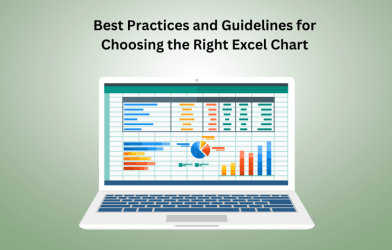
Excel serves as a powerful instrument for data visualisation, extensively utilised in academic and corporate realms. The Excel Course underscores the importance of acquiring proficiency in selecting and deploying charts suitably. With Excel Charts, intricate data transforms into comprehensible visual representations, facilitating rapid insights. To ensure the efficacy and enlightening nature of presentations and reports, this blog offers guidance on discerning the optimal Excel chart for your data, enabling clearer communication and enhanced comprehension.
Understand Your Data
Understanding the data you are working with in detail is the first step towards selecting the appropriate Chart. Understanding data goes beyond numbers. It’s about spotting trends, finding links, and telling a story. First, know your data type – time-series, comparative, or categorical. This guides you to the right Chart. Then, you can unravel the distribution, relationships, and narrative you want to convey.
Know Your Audience
The knowledge and experience of your audience in interpreting data greatly affect the way you communicate your findings. Adapting the intricacy and design of your charts to the proficiency of your audience might enhance the efficacy of your message delivery. Recall that a graphic that makes sense to a data scientist may not make sense to a person in a non-technical position.
Match the Chart to the Data Type
Charts have varying functions. To compare categories, use bar charts; to show changes over time, use line charts; to depict portions of a whole, use pie charts; and to highlight correlations or distributions, use scatter plots. Making the incorrect kind of chart selection might cloud crucial insights or result in incorrect data interpretation.
Keep It Simple
The secret to data visualisation is Simplicity. Try not to put too much information on your Chart. Reduce the amount of distracting components, such as garish colours, ornate typefaces, or superfluous graphical flourishes, and concentrate on the most important facts. Generally, a simple, uncluttered chart communicates better than one visually complex.
Use Color Effectively
Chart readability and aesthetics are greatly influenced by colour choices. Utilise them to draw the viewer’s attention to the most crucial areas of the Chart, clearly distinguish between distinct data sets, and highlight significant data points. When choosing colour schemes, keep colour blindness in mind to make sure that your data is accurately perceived by all.
Focus on Clarity and Precision
Make sure that each component of your Chart adds to its clarity. Verify that the data points are clear, the axes are appropriately labelled, and the Chart clearly communicates the intended message. A well-designed chart adds authenticity and fosters audience trust in the information you’re presenting.
Optimise Chart Labels and Legends
For accurate chart interpretation, labels and legends are necessary. Place them so as to complement the data visualisation, not to get in the way of it. Make sure they are succinct and understandable and employ them in moderation so as not to overwhelm the audience.
Consider Using Combination Charts
Use combo charts when single charts are not enough to convey the entire story. For instance, a combination of a bar chart and a line chart can efficiently illustrate the relationships between various data sets over the same time period. Make sure, nevertheless, that the combination improves rather than worsens the interpretation of the data.
Practice Accessibility
Chart design should never prioritise accessibility over other considerations. By employing accessible colour contrasts, providing alternative text for images, and taking into account other accessible design principles, you can make sure that your charts are usable by individuals with impairments. This promotes inclusivity while also expanding your audience.
Conclusion
Effective data visualisation in Excel depends on choosing the appropriate chart type. You may improve your ability to present data effectively and clearly, which will increase the persuasiveness and understanding of your reports and presentations, by adhering to these best practices and principles. Recall that the objective is to communicate the data’s story in an engaging and convincing way, not just to display it. For more information visit: The Knowledge Academy.
 Newspatrolling.com News cum Content Syndication Portal Online
Newspatrolling.com News cum Content Syndication Portal Online






